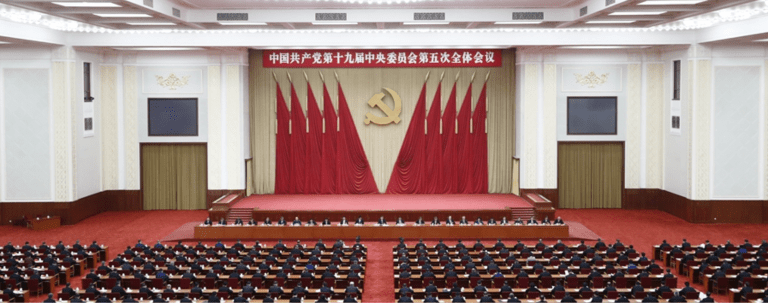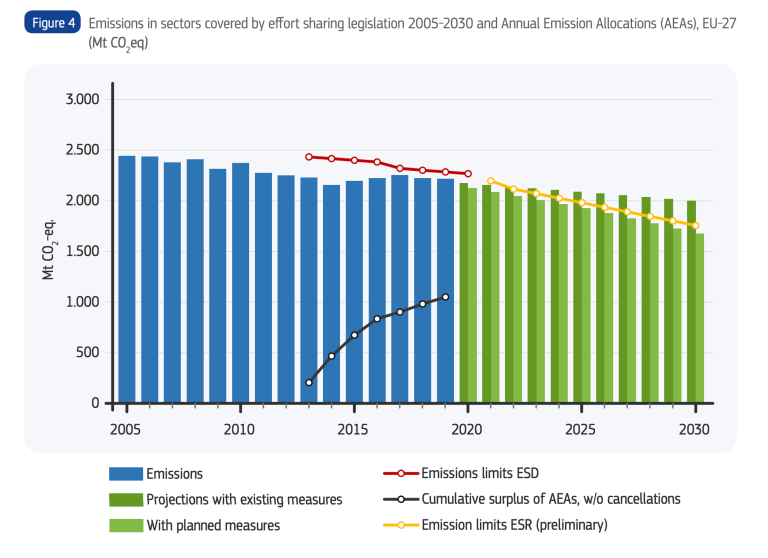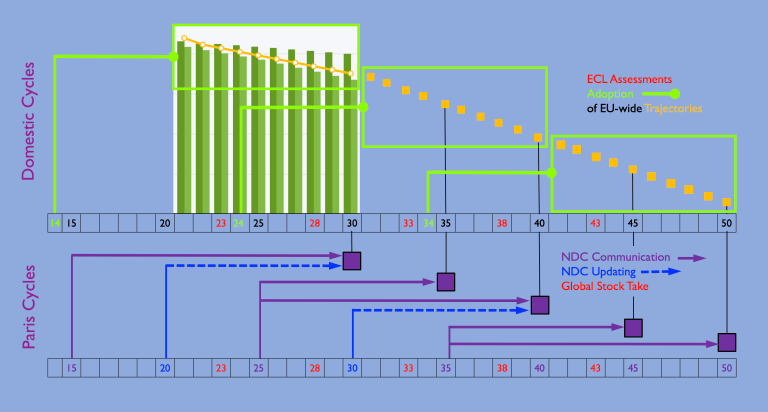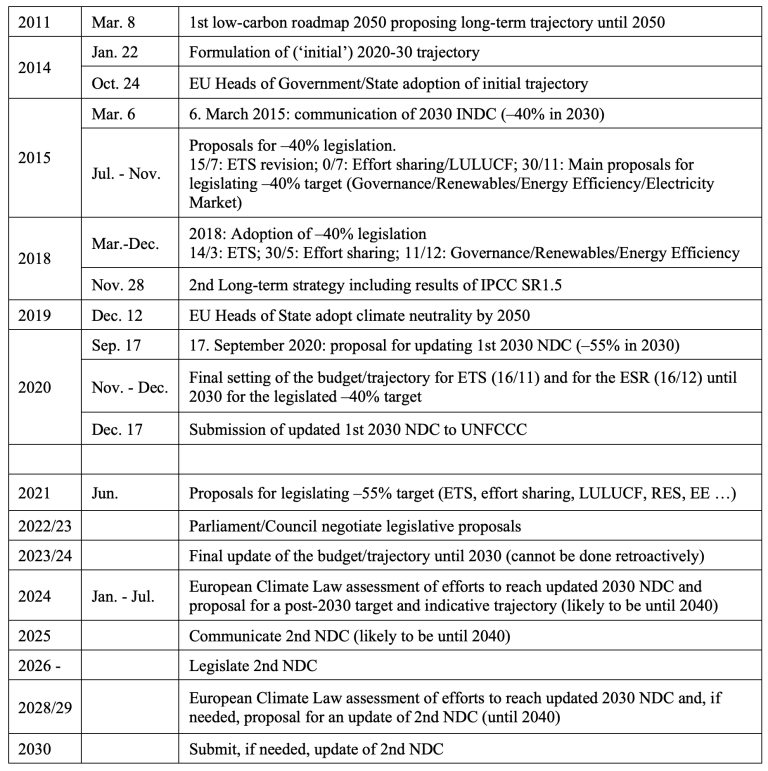This article was originally published in Oxford Climate Policy Blog
Political Summary
Two 5-year cycles currently drive the implementation of the Paris Agreement (PA): one of communicating national targets (“Nationally Determined Contributions” NDCs) and one of taking stock of global efforts. In order to complete the ambition mechanism of the PA, which is critical for its full operationalisation and the achievement of its objectives, another 5-year cycle, the “Glasgow Ambition Cycle” (GAC), aimed at ratcheting up the collective ambition of NDCs, has been proposed. It is gaining significant traction and appeal for adoption at COP 26 in Glasgow under negotiations on Common Time Frames (CTF, see Ambition Cycle on course to land in Glasgow). The GAC provides an elegant and non-controversial solution to the sticking options currently being negotiated, and is meant to start in 2025 when countries would be requested to:
- communicate (at least) a 2035 NDC (‘with a time frame up to 2035’);
- re-visit any NDCs communicated earlier to see whether, in light of changed circumstances, their ambition could be increased; and
- repeat these two steps, ceteris paribus, every five years – thus in 2030 they would be: communicating a 2040 NDC and revisiting (inter alia) the 2035 NDC communicated five years earlier, and so forth.
As recently remarked by Marianne Karlsen (Chair of the UNFCCC/PA Subsidiary Body for Implementation): “Parties are increasingly realizing the importance of the issue [CTF] to the overall dynamics and well-functioning of the Paris Agreement. Of course, it is important to keep in mind that CTF is very much a political issue because establishing timeframes often involves parliaments and cabinets. So, this has to be something that politicians also need to get on the radar to work with.”[1]
This is why this OCP blog post takes a look at domestic considerations and demonstrates that the GAC is flexible enough to be accommodated and workable in three key Parties: India, China and the European Union.
India. India has a well-established revolving five-year electricity planning cycle consisting of Electric Power Surveys (EPS) and National Electricity Plans (NEP). The Surveys involve annual demand projections for the next ten years as well as long-term (‘perspective’) projections for 15- and 20-year time horizons. The Plans contain a detailed growth strategy, including investments in generation, transmission, and distribution, for the next five years and the roadmap for the subsequent five years.
The 20th EPS, to be published in 2022, will contain yearly projections of electricity demand till 2030 and long-term projections for 2035 and 2040. The 4th NEP will be available in 2023; it will contain a detailed plan for 2022-27 and a perspective plan for 2027-32. As the electricity sector is the single largest source of GHG emissions in India, accounting for 47 per cent of the country’s total emissions, its planning cycle can be argued to be already in conformity with the GAC, and therefore in principle, the GAC can be accommodated in India’s NDC communication cycle, given the information in the 20th EPS/4th NEP.
China. China’s overall socio-economic development policy in the first half of the 21st century is dominated by two ‘Centenary Goals’; these mark the centenary of the Chinese Communist Party in 2021 and the centenary of the People’s Republic in 2049. As the mid-point between these two centenaries, 2035 has received special attention in China’s current policy making. The deliberations for the 14th Five-Year Plan (2021-25) include, for the first time, a longer-term vision with a 2035 target, which will set the development pathways for the next 15 years. This combination of short-term and long-term targets in China’s policy making is significant for global climate policy, not least because it is perfectly consistent with the proposed Glasgow Ambition Cycle.
The European Union. A key domestic consideration in the EU for determining the timeframe of climate targets is that implementing legislation can take up to 5 years to be adopted. The 2020 communication of a 2030 NDC update shows that a 2025 communication of a 2035 NDC should (in principle) be possible, even if a 2040 timeframe remains the preferred option among some of the key domestic constituents. Given that the Paris Agreement does not preclude the communication of multiple NDCs, there is no need to choose between the two options: the EU can communicate both a 2035 and a 2040 NDC in 2025, and thus take into account all domestic preferences and do so in a manner consistent with the Glasgow Ambition Cycle. The communication of a 2035 in order to facilitate a harmonisation of the GAC should not be seen as a mutually exclusive option, but rather a demonstration of political flexibility that will not prejudice the substantive essence of the EU’s overall ambition.
The Case of India: Electric Power Surveys and National Electricity Plans
India has an elaborate system for developing a National Electricity Plan every five years.[2] This system has been codified by an act of parliament – the Electricity Act of 2003 (‘the Act’). The Act obligates the Central Electricity Authority to formulate policies and plans for the development of the electricity sector, and to conduct and publish an Electric Power Survey (EPS) every five years to forecast both the country’s electricity demand and the contribution of various sources of electricity to meet that demand. The Act also stipulates the preparation of a National Electricity Plan (NEP) every five years, in accordance with India’s National Electricity Policy.
The EPS forecasts, every five years, the electricity demand for the entire country and for each State and Union Territory in the short, medium, and long term. Year-wise electricity demand projections are made for the next ten years, while long-term (perspective) demand projections are carried out for 15- and 20-year time horizons. So far, nineteen EPS have been published, the latest one in January 2017.

The 20th EPS will be published in 2022. It will contain:
- Annual electricity demand projections for each State, Union Territory, Region, and All India in detail for the years 2021 to 2031 (see figure above);[3]
- Electricity demand for the terminal years 2036 and 2041.
The NEP contains a five-year detailed plan and a 15-year perspective plan. It includes:
- Short-term and long-term demand forecast for different regions;
- Suggested areas/locations for capacity additions in generation and transmission, keeping in view the economics of generation and transmission, losses in the system, load centre requirements, grid stability, security of supply, quality of power (including voltage profile, etc.), and environmental considerations including rehabilitation and resettlement;
- Integration of possible locations of capacity additions with the transmission system and development of the national grid – including the type of transmission systems and requirement of redundancies;
- Different technologies available for efficient generation, transmission, and distribution; and,
- Fuel choices based on economy, energy security, and environmental considerations.
The latest (Third) NEP was published in January 2018. It contains a review of the previous five-years (2012-17), a detailed plan for the next five years (2017-22), and a perspectives plan for 2022-27.
The Fourth National Electricity Plan will be available in 2023. It will contain a detailed plan for 2022-27 and a perspective plan for 2027-32.
From the above, it is clear that a revolving five-year planning cycle for the electricity sector is well-established in the country. As the electricity sector is the single largest source of GHG emissions in India (accounting for 47 per cent of the country’s total emissions, including LULUCF[4]), its planning cycle could become a basis for India’s NDC communication cycle.
The Case of China: Enhanced Five-Year Planning

At the 15th National Congress of the Chinese Communist Party (CCP) in 1997, President Jiang Zemin introduced two ‘Centenary Goals’ to guide the socio-economic development in China. The first goal refers to the centenary, in 2021, of the founding of the CCP, with the Centenary Goal of building a moderately prosperous society in all respects; the second one referring to the centenary, in 2049, of the founding of the People’s Republic of China, with the goal for China to become a basically modern socialist country.
At the 19th CPC National Congress in 2017, President Xi Jinping brought forward this goal to 2035 as a new mid-term goal, with the second Centenary Goal changing to China becoming fully modernized by 2050.
Three years later, in October 2020, President Xi Jinping introduced, for the first time, a longer-term vision – a 2035 development target – in the course of the discussions on the 14th Five-Year Plan (2021-25) at the 19th meeting of the CPC Central Committee.
This new combination of short-term and longer-term targets in China’ policy making is significant not only for China’s carbon emissions peaking and carbon-neutrality targets, but also for the international climate regime.
At the time of writing, some provinces, autonomous regions, and municipalities have published their 14th FYP and 2035 long-term policy recommendations. Among these, the important mid-
and long-term policy goals related to climate change include (but are not limited to): clarifying the carbon emissions peaking action plan, limiting coal use, increasing the share of renewable energy sources in the energy mix, promoting the intelligence and digitalization of energy development models, and developing green financial service systems. These targets will become the backbone of climate policy making at regional levels in the near future.
Since the formulation of its first five-year plan 70 years ago, China has completed thirteen FYPs, and FYPs will continue to provide guidance to the socio-economic development in China, despite debates on the effectiveness of such administrative economic planning. FYPs fit well with the proposed Glasgow Ambition Cycle, particularly in conjunction with the new longer-term 2035 planning horizon.
In short, the establishment of the 2035 target enables China to play an important role in international climate change negotiations. This is crucial for the ability of China’s own adaptive measures to engage with climate change impacts domestically, and also for the joint efforts of the international community to combat climate change. Combining the carbon emissions peaking and carbon-neutrality timelines, China has the opportunity to demonstrate its contribution to climate change mitigation and also its leadership, in the near future.
The Case of the EU: The Issue of Implementing Legislation
The Glasgow Ambition Cycle crucially requires the communication of a 2035 NDC by 2025. Could this be a realistic option for the EU? A practical way to assess possibilities is to look at precedents – in this case at EU past communications under the Paris Agreement (PA).
On 6 March 2015 (see Table 1 below), the EU communicated their Intended Nationally Determined Contribution (INDC) with a ‘point target’ of emissions in 2030 being at least 40 per cent below 1990 levels, which became its initial NDC on 5 October 2016, when the EU ratified the PA.
This was based on an EU-wide emission trajectory with annual figures from 2021 to 2030, formulated and adopted by EU heads of government in 2014. The subsequent formulation and adoption of the legislation required for implementing the 40 per cent target took almost five years, beginning in July 2015 and ending in December 2020 with the setting of the final 40 per cent target trajectory.
In March 2020, the Commission promulgated the European Climate Law [ECL], which not only mandates the EU to be ‘climate-neutral’ by 2050, but also “proposes the adoption of a 2030-2050 EU-wide trajectory for greenhouse gas emission reductions”[ECL], and five-yearly assessments of “the consistency of EU and national measures with the climate-neutrality objective and the 2030-2050 trajectory”[ECL], synchronized with the Global Stocktakes of the Paris Agreement.
On 17 December 2020, the EU communicated an update of their initial NDC with a new, more ambitious target of at least 55 per cent below the 1990 level for 2030 emissions and – according to the EU Climate Action Progress Report, November 2020 (see also Figure 1) – the Commission is currently determining the annual emissions allocations (AEAs) for each country for the years 2021 – 2030, to take into account the updated, more ambitious, 2030 target.

What is to happen next? In a first instance, new implementing legislation for the 55 per cent target will have to be adopted, and it is expected that this will take (at least) until 2024, which means that in practice the implementation of the updated 55 per cent NDC is unlikely to commence before 2025.

Assuming the adoption of the ECL by 2022, the next milestone will be the first of the ECL-mandated assessments in 2023. Following the pattern seen in the run up to the 2015 communication of the (I)NDC, it stands to reason – not least on the basis of the position of the European Council (see Box 1) – that this will be followed by the formulation and adoption of a second ten-year trajectory (2031-40, see Figure 2), presumably based on the 2050 net-zero trajectory mandated in the ECL.

According to Art. 4.9 of the PA, all Parties have to communicate an NDC in 2025. The key question in the present context is about what timeframes the EU could realistically consider in light of domestic considerations?
One of the key domestic constraints, the time it takes to adopt the required implementing legislation (up to 5 years, as mentioned above), for one rules out another update of the 2030 NDC.
Given the INDC precedent, one option clearly is the communication of a 2040 NDC. But, to be sure, the 2020 communication of the updated 2030 NDC equally provides a precedent for the option of communicating a 2035 NDC, which seems to be the preferred option of a number of Member States,[5] and is consistent with the GAC. Fortunately, Art. 4.9 allows for multiple NDCs to be communicated simultaneously, so that there is no need to choose one over the other.
In short, keeping in mind the domestic legislative constraints, it is possible (as illustrated in Figure 2) for the EU to include the communication pattern set in Paris in a cycle that would be consistent with the GAC by communicating both a 2035 and a 2040 NDC in 2025, updating the 2040 NDC in 2030, and communicating a 2045 NDC and the 2050 (‘net-zero’) NDC in 2035.

The authors would like to acknowledge, with gratitude, feedback received (in alphabetical order) by Annika Christell, Kishan Kumarsingh, Geert Fremout, and Artur Runge-Metzger.
[1] Source: In conversation with SBI and SBSTA Chairs ERCST.
[2] References:
- The Electricity Act, 2003 (available at http://www.cercind.gov.in/act-with-amendment.pdf).
- 19th Electric Power Survey, 2017 (available at https://cea.nic.in/wp-content/uploads/2020/04/summary_19th_eps.pdf).
- National Electricity Plan, 2018 (available at https://cea.nic.in/wp-content/uploads/2020/04/nep_jan_2018.pdf).
[3] Note that strictly speaking, the projections are made for financial years, starting in April and ending in March of the following calendar year. However, to avoid cumbersome notation, the calendar year of the initial nine months is here used to designate the financial year in question, i.e., ‘2020’ instead of ‘FY 2020-21’.
[4] MoEFCC. (2018). India: Second Biennial Update Report to the United Nations Framework Convention on Climate Change. Ministry of Environment, Forest and Climate Change, Government of India.
[5] See Appendix 3 in Enhance Climate Ambition in 2020: Here’s looking at EU, kid!
